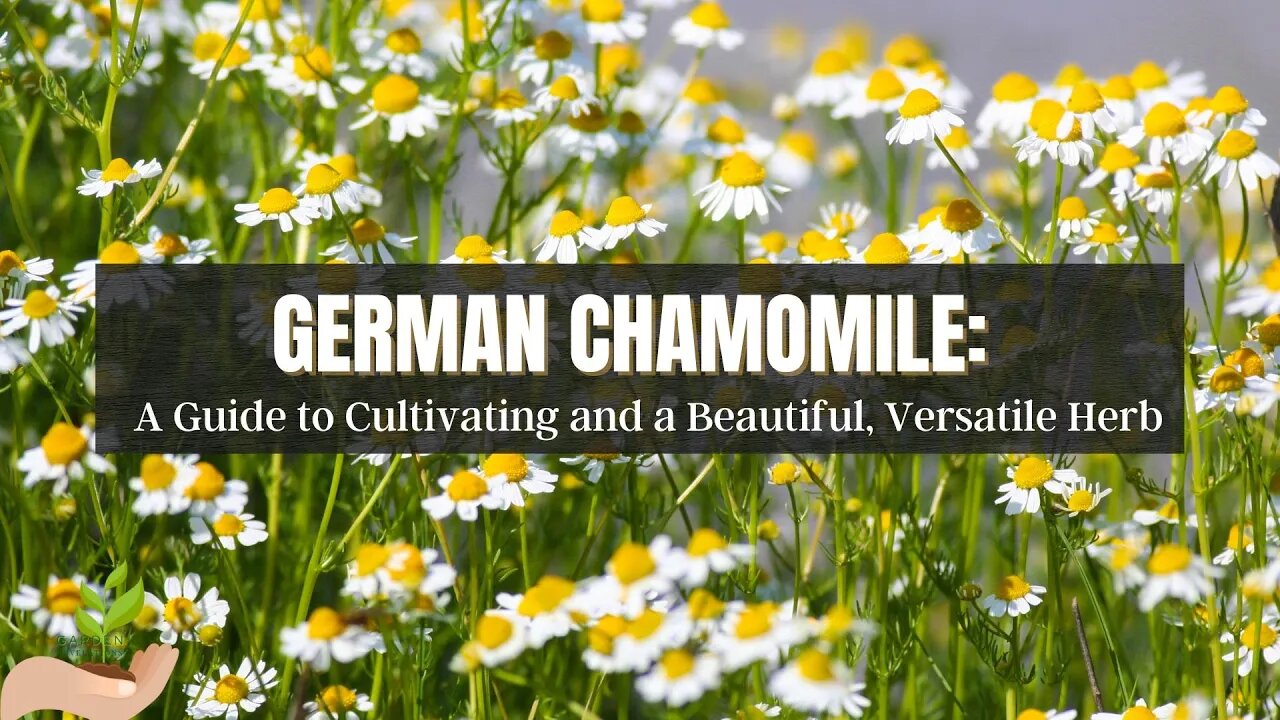Premium Only Content

German Chamomile: A Guide to Cultivating and Utilizing this Versatile Herb
German chamomile, with the Latin name Matricaria chamomilla, is a flowering herb used for centuries for its medicinal and culinary properties. This versatile plant belongs to the Asteraceae family and is native to Europe and Western Asia. German chamomile is known for its delicate, daisy-like flowers with white petals and yellow centers, which have a sweet, apple-like fragrance.
Whether you are a seasoned gardener, or you're new to this productive hobby, this content will provide a comprehensive guide to planting German chamomile.
Matricaria chamomilla is a small, herbaceous plant from the Asteraceae family. It is an annual plant that can reach up to two feet tall, with delicate, feathery leaves that are light green. The flowers of German chamomile are small, daisy-like, and have a characteristic fragrance that is sweet and apple-like.
German chamomile flowers are ready to harvest when fully open when they are at their peak potency for medicinal and culinary use. The flowers have white petals and yellow centers and form a flat-topped cluster at the top of the stem.
It is essential to differentiate between German and Roman chamomile, another common chamomile species. While both plants have similar medicinal and culinary properties, they have some critical differences in their botanical features.
Roman chamomile, or Chamaemelum nobile, is a perennial plant with a more upright growth habit and smaller, more compact flowers than German chamomile. Roman chamomile has a slightly different fragrance than German chamomile, with a more earthy and herbaceous aroma.
Understanding the botanical features of German chamomile and differentiating it from other chamomile species is essential for the successful cultivation and proper use of this herb.
German chamomile is a relatively easy herb to grow in most climates. It prefers the full sun to partial shade and well-draining soil. It is hardy in growing zones 3 to 9 and can be grown as an annual in cooler zones or biennial in warmer areas. That depends on the climate and growing conditions.
To cultivate German chamomile, you must start by preparing the soil. Choosing a location with well-draining soil is important, as it does not tolerate standing water. To improve drainage and fertility, you can amend the soil with compost or another organic material.
Once you prep the soil, you can plant the seeds directly in the ground after the last frost. It is best to sow the seeds thinly and cover them lightly with soil. The seeds will germinate within 7 to 14 days and should be moist until they sprout.
German chamomile requires consistent watering throughout the growing season. It is vital to water the plant deeply, but avoid overwatering, because this can lead to root rot. Fertilizing the plant with a balanced monthly fertilizer can also help promote healthy growth and flowering.
Common pests and diseases affecting German chamomile include aphids, spider mites, and powdery mildew. Practice good garden hygiene and remove any dead or diseased plant material promptly to prevent these concerns. Also, you can use organic pest control methods, like insecticide soap or neem oil, to control pests.
German chamomile, or Matricaria chamomilla, is a versatile herb enjoying popularity for centuries for its many uses. Its delicate, daisy-like flowers with white petals and yellow centers have a sweet, apple-like fragrance that is so easily recognizable. German chamomile is easy to grow and can be cultivated in most climates, making it a terrific choice for gardeners of all skill levels.
Connect with us
Facebook: https://www.facebook.com/TayloesLawnCare
Web: https://www.tayloeslawncare.com
MeWe: https://mewe.com/p/diyhomegarden
Image and music licensed via Canva Pro
-
 0:56
0:56
Garden Revelations
1 year agoPansies: The perfect way to add color to a fall garden (lasting to early winter in North Carolina)
77 -
 DVR
DVR
Game On!
10 hours ago $2.32 earnedThe Miami Dolphins FINALLY Win a Prime Time Game!
30K -
 16:27
16:27
This Bahamian Gyal
1 day agoBLACK woman calls MAGA supporter SELLOUT at PISTONS game
30.6K30 -
 18:35
18:35
Neil McCoy-Ward
20 hours ago🇺🇸 TRUMP 🇺🇸 Just Dropped An Absolute BOMBSHELL… (THINGS ARE ABOUT TO GET CRAZY!)
12.3K25 -
 7:49
7:49
Misha Petrov
13 hours agoThe SHOCKING Disrespect Toward U.S. Veterans
10.2K39 -
 20:17
20:17
RTT: Guns & Gear
18 hours ago $2.13 earnedIs This The Best Glock Clone For Under $300 | Bear Creek Arsenal Grizzly BC-102
11.7K8 -
 59:49
59:49
The Tom Renz Show
21 hours ago"NC is Still a Disaster and the People There Still Matter - With Joshua Macias"
15.3K3 -
 7:22
7:22
Dr David Jockers
18 hours ago $2.29 earned1 Teaspoon Per Day Burns Belly Fat Quickly
23K1 -
 1:21:34
1:21:34
Josh Pate's College Football Show
1 day ago $25.26 earnedWeek 11 Reaction Show: Alabama Rolls LSU | Ole Miss Owns UGA | Miami Falls | AP Poll vs JP Poll
83.4K6 -
 30:01
30:01
Shrouded Hand
1 day ago $15.49 earnedThree Disturbing Missing Child Cases
59.2K14